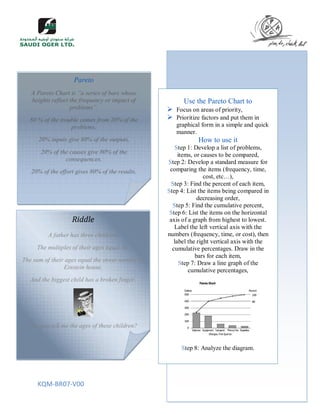Recommended
More Related Content
What's hot
What's hot (19)
13 Types of Infographics You Can Use for Business and Marketing

13 Types of Infographics You Can Use for Business and Marketing
MELJUN CORTES research seminar_1_presentation_techniques

MELJUN CORTES research seminar_1_presentation_techniques
Similar to Pareto
Similar to Pareto (20)
Quality Control tool Quality Control tool220216.ppt

Quality Control tool Quality Control tool220216.ppt
Dervy bis-155-i lab-8-week-7-descriptive-statistics-formatting--graphs-and-re...

Dervy bis-155-i lab-8-week-7-descriptive-statistics-formatting--graphs-and-re...
7 QC quality control (7 QC) tools for continuous improvement of manufacturing...

7 QC quality control (7 QC) tools for continuous improvement of manufacturing...
Qcl 14-v3 [pareto diagram]-[banathali_university]_[suyashi_rastogi]![Qcl 14-v3 [pareto diagram]-[banathali_university]_[suyashi_rastogi]](data:image/gif;base64,R0lGODlhAQABAIAAAAAAAP///yH5BAEAAAAALAAAAAABAAEAAAIBRAA7)
![Qcl 14-v3 [pareto diagram]-[banathali_university]_[suyashi_rastogi]](data:image/gif;base64,R0lGODlhAQABAIAAAAAAAP///yH5BAEAAAAALAAAAAABAAEAAAIBRAA7)
Qcl 14-v3 [pareto diagram]-[banathali_university]_[suyashi_rastogi]
More from Tarraf Al Akoum
More from Tarraf Al Akoum (10)
Pareto
- 1. KQM-BR07-V00 Use the Pareto Chart to Focus on areas of priority, Prioritize factors and put them in graphical form in a simple and quick manner. How to use it Step 1: Develop a list of problems, items, or causes to be compared, Step 2: Develop a standard measure for comparing the items (frequency, time, cost, etc…), Step 3: Find the percent of each item, Step 4: List the items being compared in decreasing order, Step 5: Find the cumulative percent, Step 6: List the items on the horizontal axis of a graph from highest to lowest. Label the left vertical axis with the numbers (frequency, time, or cost), then label the right vertical axis with the cumulative percentages. Draw in the bars for each item, Step 7: Draw a line graph of the cumulative percentages, Step 8: Analyze the diagram. Riddle A father has three children: The multiples of their ages equal 36, The sum of their ages equal the street number of Einstein house, And the biggest child has a broken finger. Can you tell me the ages of these children? Pareto A Pareto Chart is “a series of bars whose heights reflect the frequency or impact of problems”. 80 % of the trouble comes from 20% of the problems, 20% inputs give 80% of the outputs, 20% of the causes give 80% of the consequences, 20% of the effort gives 80% of the results.
